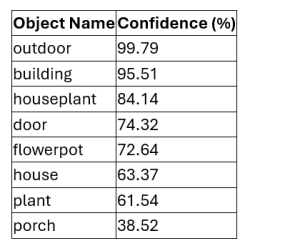Exploring a practical application for Computer Vision in process automation
Image validation and manual review are often overlooked sources of inefficiency. When teams are forced to sift through thousands of photos – whether from delivery drivers, field engineers or customers – it eats into valuable time, slows decisions and makes it harder to enforce consistent standards.
In this article, we explore how Circyl used Azure Computer Vision AI to analyse delivery photos, detect anomalies and reduce the need for manual checks. By automating this process, we’re demonstrating how intelligent image classification can support faster processing, clearer audit trails and tighter fraud prevention – all with minimal setup.
The Problem with Manual Image Verification
Delivery drivers are often asked to submit a photo after an attempted drop-off. That image then needs to be checked to make sure it meets certain criteria – for example, confirming the presence of a door in the shot.
Currently, this process is completely manual. Staff need to open the image, assess the setting, and approve or reject it based on vague visual rules. It is slow, repetitive, error-prone and – in truth – boring. It is also easy for dishonest actors to upload duplicates or trick the system.
So, we asked: could AI automate this task and spot the images worth flagging, while allowing valid ones to pass through automatically?
The Technical Approach: Azure Computer Vision AI
We designed a proof-of-concept using Azure Computer Vision and Logic Apps. The workflow includes:
- Logging and Duplicate Detection
- When an image is submitted (via email in this case), a unique checksum is generated using an API.
- That checksum is checked against a SQL Server database to see if the same image has already been submitted.
- If it is a duplicate, the system can ignore or flag it automatically.
- Image Analysis with Azure AI
- If the image passes the duplication check, it is sent to the Azure Computer Vision API.
- The AI analyses the contents and returns a set of objects it recognises, each with a confidence score.
- If a “door” is detected with high confidence, the image is approved. If not, it is flagged for review.
- Training for More Specific Scenarios
- For more advanced use cases, we can integrate Azure Custom Vision AI, which allows us to train the model with business-specific object libraries.
- This could be used to detect vehicle damage, assess product quality, or identify safety issues on a construction site.
A Quick Example
To test the logic, we sent a stock image of a doorstep delivery to the Logic App:

- The image was logged, a checksum created and stored.
- The Logic App passed the image to the Vision API.
- The system emailed back the detected objects and confidence levels.

Without any custom training, the AI identified key contextual elements – including a door – with high confidence. For an off-the-shelf model, the result was very encouraging and showed clear value as a base for business-grade automation.
Wider Use Cases
This approach could easily extend to other scenarios, including:
- Detecting vehicle damage in insurance claims or fleet inspections.
- Flagging health and safety breaches in photos or camera feeds.
- Automating quality control in production lines using product images.
- Spotting and blocking image-based fraud, such as repeated or doctored uploads.
By combining Azure Computer Vision with Logic Apps or Power Automate, businesses can create robust, scalable automation flows that integrate seamlessly with wider processes and databases.
How Could This Help You?
Every business is looking for ways to reduce manual effort and boost operational accuracy – especially in areas that scale poorly, like image review. With AI-driven classification and validation, it becomes possible to speed up processing, reduce errors and remove bottlenecks without relying on full human oversight.
This proof-of-concept shows what is possible. If you’re interested in building something similar – or seeing a live demo of the solution – get in touch with the Circyl team.
Like what you read? Share it!
Get in touch
If you'd like to know more, get in touch using the form below, call 03333 209 969 or email enquiries@circyl.co.uk.
